The SSD Relapse: Understanding and Choosing the Best SSD
by Anand Lal Shimpi on August 30, 2009 12:00 AM EST- Posted in
- Storage
Overall System Performance using PCMark Vantage
Next up is PCMark Vantage, another system-wide performance suite. For those of you who aren’t familiar with PCMark Vantage, it ends up being the most real-world-like hard drive test I can come up with. It runs things like application launches, file searches, web browsing, contacts searching, video playback, photo editing and other completely mundane but real-world tasks. I’ve described the benchmark in great detail before but if you’d like to read up on what it does in particular, take a look at Futuremark’s whitepaper on the benchmark; it’s not perfect, but it’s good enough to be a member of a comprehensive storage benchmark suite. Any performance impacts here would most likely be reflected in the real world.
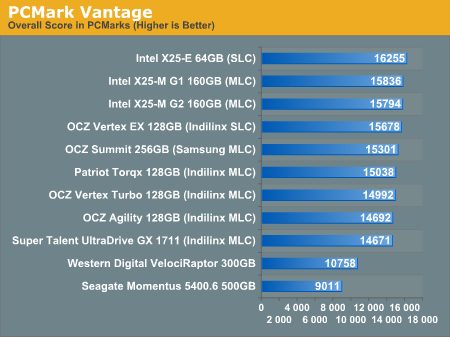
The overall PCMark Vantage score takes into account CPU and GPU performance and thus storage performance is only one aspect of determining your score. All of the SSDs do well here, the slowest configuration still around 36% faster than the WD VelociRaptor; something I'd say is more than reflected in real world performance.
The memories suite includes a test involving importing pictures into Windows Photo Gallery and editing them, a fairly benign task that easily falls into the category of being very influenced by disk performance.
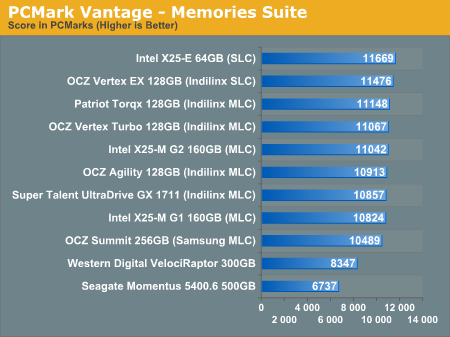
Once again the SSDs all perform very similarly here. The fastest of the group is Intel's X25-E, but the Indilinx drives actually hold the next three spots followed by the new G2. The performance range is very small between these drives though, you honestly can't go wrong with either an Indilinx MLC or X25-M.
The TV and Movies tests focus on on video transcoding which is mostly CPU bound, but one of the tests involves Windows Media Center which tends to be disk bound.
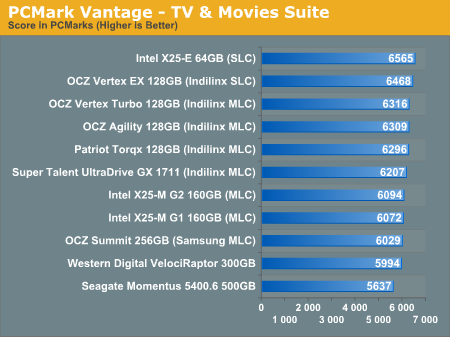
The standings continue to be roughly the same. We see just how much more competitive Indilinx is this time around than when the OCZ Vertex first hit the streets. We do have a real alternative to Intel.
The gaming tests are very well suited to SSDs since they spend a good portion of their time focusing on reading textures and loading level data. All of the SSDs dominate here, but as you'll see later on in my gaming tests the benefits of an SSD really vary depending on the game. Take these results as a best case scenario of what can happen, not the norm.
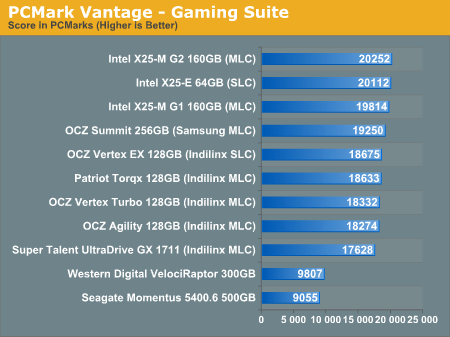
The Vantage Gaming Suite shows us our first example of the X25-M G2 pulling ahead of even the SLC X25-E. Even the Samsung based OCZ Summit does very well here.
In the Music suite the main test is a multitasking scenario: the test simulates surfing the web in IE7, transcoding an audio file and adding music to Windows Media Player (the most disk intensive portion of the test).
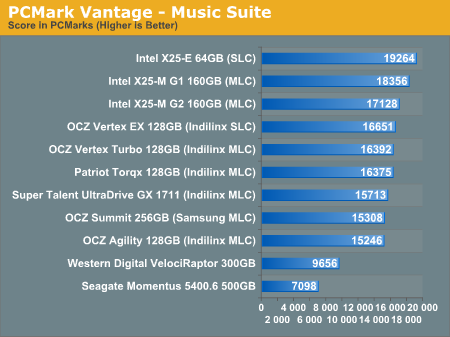
The Intel drives are at the top, the G1 faster than the G2, followed by the Indilinx drives, then the Samsung drive and the mechanical drives. New performance is important here because once TRIM shows up, this is closer to what you'll be seeing for a drive with a good amount of free space.
The Communications suite is made up of two tests, both involving light multitasking. The first test simulates data encryption/decryption while running message rules in Windows Mail. The second test simulates web surfing (including opening/closing tabs) in IE7, data decryption and running Windows Defender.
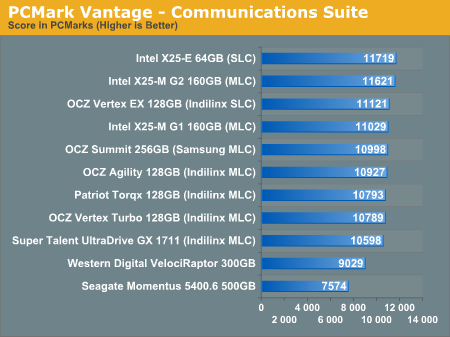
I love PCMark's Productivity test; in this test there are four tasks going on at once, searching through Windows contacts, searching through Windows Mail, browsing multiple webpages in IE7 and loading applications. This is as real world of a scenario as you get and it happens to be representative of one of the most frustrating HDD usage models - trying to do multiple things at once. There's nothing more annoying than trying to launch a simple application while you're doing other things in the background and have the load take seemingly forever.
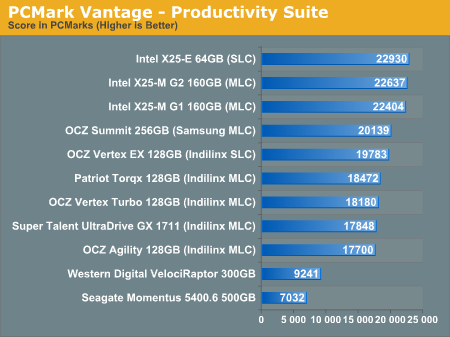
Here the Intel drives are at the top, by a noticeable margin. The G1, G2 and X25-E are all around the same level of performance. Samsung comes close with the OCZ Summit and the Indilinx drives pull up the rear. You can't go wrong with either the Intel or Indilinx drives but Intel is clearly faster here.
The final PCMark Vantage suite is HDD specific and this is where you'll see the biggest differences between the drives:
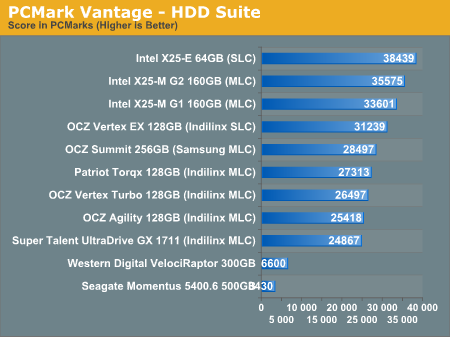
When it comes to pure drive performance, the breakdown doesn't get any simpler. Intel's X25-E holds the top spot, followed by the G2 and G1. While the G2 is only 5.6% faster than the G1, remember that we're looking at "new" performance here. Over time, with TRIM, the G2 will be closer to this performance, while the G1 will never get here again.
Despite poor random small file write performance, the OCZ Summit actually does very well here.
All of the drives perform incredibly compared to any mechanical hard drives.










295 Comments
View All Comments
minime - Tuesday, September 1, 2009 - link
Thanks for that, but still, this is not quite a real business test, right?Live - Monday, August 31, 2009 - link
Great article! Again I might add.Just a quick question:
In the article it says all Indilinx drives are basically the same. But there are 2 controllers:
Indilinx IDX110M00-FC
Indilinx IDX110M00-LC
What's the difference?
yacoub - Monday, August 31, 2009 - link
If Idle Garbage Collection cannot be turned off, how can it be called "[Another] option that Indilinx provides its users"? If it's not optional, it's not an option. :(Anand Lal Shimpi - Monday, August 31, 2009 - link
Well it's sort of optional since you had to upgrade to the idle GC firmware to enable it. That firmware has since been pulled and I've informed at least one of the companies involved of the dangers associated with it. We'll see what happens...Take care,
Anand
helloAnand - Monday, August 31, 2009 - link
Anand,The best way to test compiler performance is compiling the compiler itself ;). GCC has an enormous test suite (I/O bound) to boot. Building it on windows is complicated, so you can try compiling the latest version on the mac.
Anand Lal Shimpi - Monday, August 31, 2009 - link
Hmm I've never played with the gcc test suite, got any pointers you can email me? :)Take care,
Anand
UNHchabo - Tuesday, September 1, 2009 - link
Compiling almost anything on Visual Studio also tends to be IO-bound, so you could try that as well.CMGuy - Wednesday, September 2, 2009 - link
We've got a few big java apps at work and the compile times are heavily I/O bound. Like it takes 30 minutes to build on a 15 disk SAN array (The cpu usage barely gets above 30%). Got a 160Gig G2 on order, very much looking forward to benchmarking the build on it!CMGuy - Sunday, October 11, 2009 - link
Finally got an X25-m G2 to benchmark our builds on. What was previously a 30 minute build on a 15 disk SAN array in a server has become a 6.5 minute build on my laptop.The real plus has come when running multiple builds simultaneously. Previously 2 builds running together would take around 50 minutes to complete (not great for Continuous Integration). With the intel SSD - 10 minutes and the bottleneck is now the CPU. I see more cores and hyperthreading in my future...
Ipatinga - Monday, August 31, 2009 - link
Another great article about SSD, Anand. Big as always, but this is not just a SSD review or roundup. It´s a SSD class.Here are my points about some stuff:
1 - Correct me if I´m wrong, but as far as capacity goes, this is what I know:
- Manufacturers says their drive has 80GB, because it actually has 80GB. GB comes from GIGA, wich is a decimal unit (base 10).
- Microsoft is dumb, so Windows follows it, and while the OS says your 80GB drive has 74,5GB, it should say 80GB (GIGA). When windows says 74,5, it should use Gi (Gibi), wich is a binary unit).
- To sum up, with a 80GB drive, Windows should say it has 80GB or 74,5GiB.
- A SSD from Intel has more space than it´s advertised 80GB (or 74,5GiB), and that´s to use as a spare area. That´s it. Intel is smart for using this (since the spare area is, well, big and does a good job for wear and performance over sometime).
2 - I wonder why Intel is holding back on the 320GB X25-M... just she knows... it must be something dark behind it...
Maybe, just maybe, like in a dream, Intel could be working on a 320GB X25-M that comes with a second controller (like a mirror of the one side pcb it has now). This would be awesome... like the best RAID 0 from two 160GB, in one X25-M.
3 - Indilinx seems to be doing a good job... even without TRIM support at it´s best, the garbage cleaning system is another good tool to add to a SSD. Maybe with TRIM around, the garbage cleaning will become more like a "SSD defrag".
4 - About the firmware procedure in Indilinx SSD goes, as far as I know, some manufacturers use the no-jumper scheme to make easier the user´s life, others offer the jumper scheme (like G.Skill on it´s Falcon SSD) to get better security: if the user is using the jumper and the firmware update goes bad, the user can keep flashing the firmware without any problem. Without the jumper scheme, you better get lucky if things don´t go well on the first try. Nevertheless, G.Skill could put the SSD pins closer to the edge... to put a jumper in those pins today is a pain in the @$$.
5 - I must ask you Anand, did you get any huge variations on the SSD benchmarks? Even with a dirty drive, the G.Skill Falcon (I tested) sometimes perform better than when new (or after wiper). The Benchmarks are Vantage, CrystalMark, HD Tach, HD Tune.... very weird. Also, when in new state, my Vantage scores are all around in all 8 tests... sometimes it´s 0, sometimes it´s 50, sometimes it´s 100, sometimes it´s 150 (all thousand)... very weird indeed.
6 - The SSD race today is very interesting. Good bye Seagate and WD... kings of HD... Welcome Intel, Super Talent, G.Skill, Corsair, Patriot, bla bla bla. OCZ is also going hard on SSD... and I like to see that. Very big line of SSD models for you to choose and they are doind a good job with Indilinx.
7 - Samsung? Should be on the edge of SSD, but manage to loose the race on the end user side. No firmware update system? You gotta be kidding, right? Thank good for Indilinx (and Intel, but there is not TRIM for G1... another mistake).
8 - And yes... SSD rocks (huge performance benefit on a notebook)... even though I had just one weekend with them. Forget about burst speed... SSD crushes hard drives where it matters, specially sequencial read/write and low latency.
- Let me finish here... this comment is freaking big.